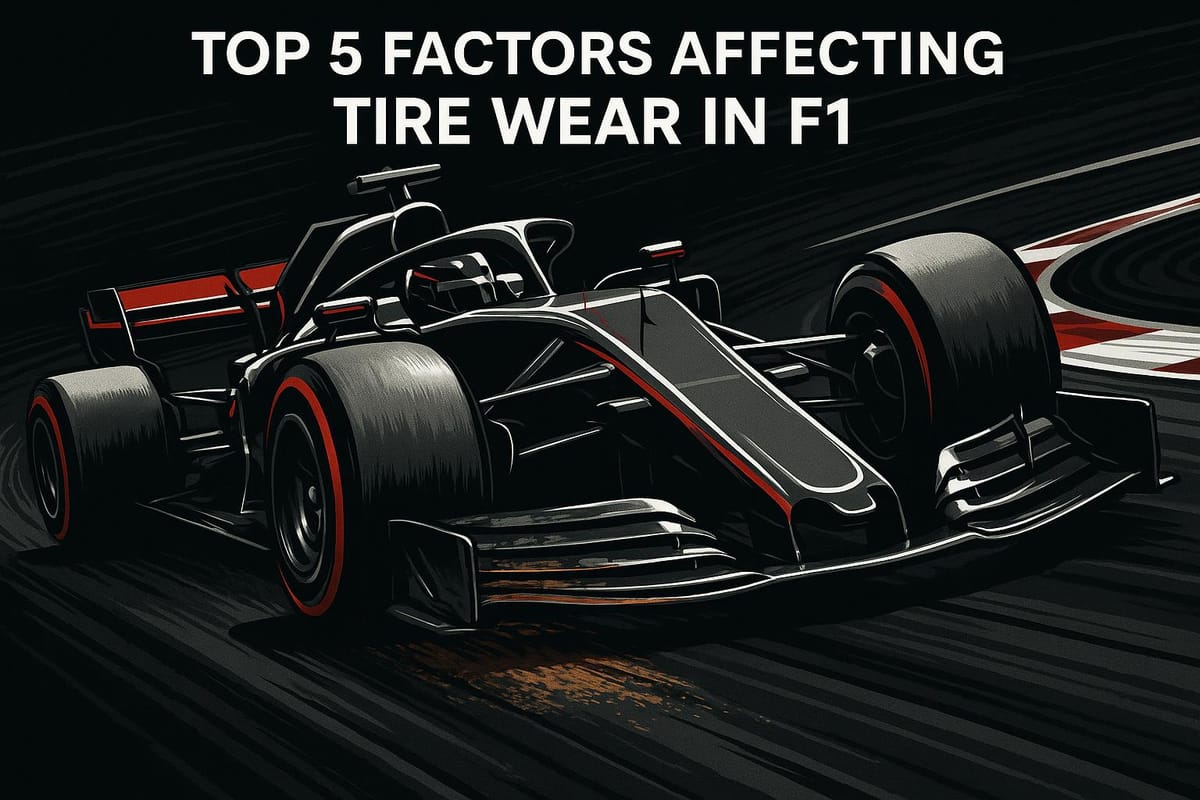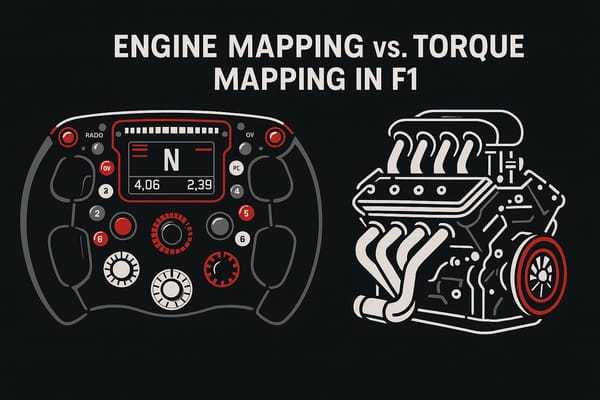Top 5 Factors Affecting Tire Wear in F1
Explore the key factors impacting tire wear in Formula 1, including track conditions, temperature, car setup, driving style, and tire choice.

Tire wear is one of the biggest challenges in Formula 1. A single set of tires can lose over 2 kg of rubber during a race, and poor tire management can cost drivers precious seconds. Here’s a quick summary of the top factors that impact tire wear in F1:
- Track Surface & Layout: Rough tracks like Silverstone cause faster wear, while smoother tracks like Monaco are gentler on tires.
- Temperature: Tires need to stay within an ideal temperature range. Too hot or too cold, and they degrade quickly.
- Car Setup: Adjustments like suspension and downforce balance grip and wear but can stress tires differently.
- Driving Style: Smooth driving extends tire life, while aggressive techniques cause uneven wear and overheating.
- Tire Choice & Pressure: The right compound and pressure are critical for balancing performance and durability.
Quick Comparison of Key Factors
| Factor | Impact on Tires | Example |
|---|---|---|
| Track Surface | Rough surfaces increase wear; smooth surfaces are gentler but harder to heat tires | Silverstone vs. Monaco |
| Temperature | Optimal range ensures grip; extremes lead to faster degradation | 41°F to 108.5°F challenges |
| Car Setup | Downforce and suspension tweaks affect grip and wear | High-speed vs. technical tracks |
| Driving Style | Smooth driving reduces wear; aggressive driving shortens tire life | Lewis Hamilton vs. aggressive |
| Tire Choice/Pressure | Soft tires grip better but wear quickly; pressure changes affect contact patch | Soft vs. hard compounds |
Mastering these factors is key to winning races. Teams rely on real-time data and precise strategies to manage tires effectively. Read on to learn how each factor plays a role in F1 tire performance.
Tyre Wear VS Tyre Degradation in F1
1. Track Surface and Layout Effects
The surface and layout of a track play a crucial role in determining tire wear in Formula 1. The way tires interact with the asphalt can lead to varying levels of friction and abrasion, which directly affect their performance and lifespan.
Surface Roughness and Tire Wear
The roughness of a track's surface has a major impact on how quickly tires degrade due to mechanical wear. Hirohide Hamashima, Bridgestone Motorsport's Director of Motorsport Tire Development, explains:
"There is a big difference between the extremes of the smoother surface circuits we visit, such as Monaco and Montreal, and the more abrasive circuits such as Silverstone and Barcelona."
Smooth surfaces, like those at Monaco, tend to cause less mechanical wear but can make it harder to achieve optimal tire temperatures. On the other hand, rougher, more abrasive tracks like Silverstone wear tires down faster but often provide better initial grip.
The Role of Circuit Layout
The layout of a circuit also plays a big part in how tires are stressed. High-speed corners, especially sequences like esses, create significant energy transfer, which heats the tires rapidly. Silverstone, for instance, is notorious for its high-speed corner sequences, with Pirelli noting that it generates "the biggest forces ever seen" on tires.
Here’s a quick comparison between high-wear and low-wear tracks:
| Characteristic | High-Wear Tracks (e.g., Silverstone) | Low-Wear Tracks (e.g., Monza) |
|---|---|---|
| Surface Type | Highly abrasive | Smooth |
| Layout Features | Multiple high-speed corners | Long straights (75% full throttle) |
| Tire Load | High lateral forces | Lower cornering forces |
| Average Speed | Variable with technical sections | 164+ mph record average speed |
| Pit Strategy | Multiple stops often required | Fewer pit stops needed |
Track Evolution Over the Weekend
The challenges posed by surface and layout are further complicated by track evolution. As the weekend progresses, rubber builds up on the racing line, altering grip levels - a phenomenon known as track evolution. Teams must adapt their tire strategies to these changing conditions.
Eric Blandin, deputy technical director at Aston Martin Aramco F1 Team, emphasizes the importance of selecting the right tire compound for a given track:
"Soft compounds are easier to warm up and to reach their optimum temperature, so are better suited to cool conditions and smooth tracks with less high-speed corners, where it is typically difficult to get enough energy into the tyres. Whereas hard compounds are more robust and so can generate grip at tracks with high surface temperatures and roughness, without overheating or damaging the surface of the tyre."
These extreme demands highlight the unique nature of F1 tires. While a regular road car tire can last up to 40,000 miles, F1 tires are pushed to their limits, often wearing out after just 188 miles under race conditions.
2. Temperature Impact on Tires
Temperature plays a key role in tire grip and wear, making it essential for teams to fine-tune their strategies to align with both ambient and track conditions for the best results.
Operating Temperature Ranges
Simone Berra, Formula 1 chief engineer at Pirelli, highlights the importance of maintaining tire temperatures within a specific range:
"The working range is the window of temperature where the tyres generate the maximum grip. If the tyres are too cold, the rubber compound can become stiff. If it is too hot, its modulus decreases and the tyres degrade. Both cases lead to lower grip, so to exploit the peak performance of the compound, teams try to keep their tyres within this working range."
The challenge lies in dealing with fluctuating track temperatures, which have historically spanned from 41°F to 108.5°F (5°C to 42.5°C). To navigate these extremes, teams rely on precise techniques to maintain tire performance within the ideal range.
Temperature Management Techniques
Effectively managing tire temperatures is critical to controlling wear and ensuring consistent performance. For example, heating the wheel rim by 10°C can raise the tire carcass temperature by 1°C. Drivers and teams use several strategies to keep tire temperatures in check:
- Brake Bias Adjustment: Generates heat that transfers through the wheel rim, raising tire temperatures.
- Lift and Coast: Reduces the load on the tires, helping to cool them and prevent overheating.
- Compound Selection: Matches the tire type to the expected track and weather conditions for optimal performance.
These techniques are effective under normal conditions, but extreme heat or cold can still push tires beyond their limits.
Extreme Temperature Challenges
When temperatures soar, managing tires becomes even more complex. Inside the cockpit, temperatures can climb to 140°F, while brake systems can reach a blistering 1,832°F. Such extreme heat accelerates tire degradation, forcing teams to adapt their strategies in real time.
A striking example of this was the 2020 Turkish Grand Prix. The newly resurfaced track, paired with unpredictable temperature swings, created a perfect storm for tire management issues. Teams had to continuously tweak their approaches to keep tires performing well, whether in dry or wet conditions. This race demonstrated just how critical temperature control is in Formula 1.
3. Car Setup and Downforce
Fine-tuning aerodynamics while ensuring tire longevity is one of the biggest challenges in Formula 1. Teams must strike a delicate balance between maximizing grip and avoiding excessive tire wear.
The Role of Suspension Geometry
Suspension settings play a crucial role in how tires interact with the track. Massimo Zecchinelli, a Setup and Telemetry Specialist, explains:
"The goal of good suspension geometry is to help you extract as much traction as possible from your tires."
Here are some of the key suspension adjustments:
- Camber Settings: Increasing negative camber at the front enhances cornering grip but can lead to faster tire wear.
- Toe Angles: Front toe-out reduces understeer, but it can also make the car less stable.
- Spring Rates: These are adjusted based on the track's surface and the demands of its corners.
While suspension settings are critical, aerodynamic tweaks also have a significant impact on tire behavior.
Downforce: Grip vs. Wear
At speeds of 81 mph, an F1 car generates downforce equivalent to its weight. Higher downforce increases the load on the tires - up to 2,000 pounds - improving grip. However, this added load accelerates tire wear. On the flip side, reducing downforce decreases grip, which can lead to sliding and further tire degradation.
Tailoring Setups for Each Circuit
Every track presents unique challenges, requiring teams to adapt their setups to balance performance with tire preservation. Adjustments to ride height, spring rates, and anti-roll bars are tailored to the specific demands of each circuit:
- Bumpy Tracks: Softer suspension and higher ride height help manage uneven surfaces.
- Smooth, High-Speed Circuits: Stiffer setups optimize aerodynamic efficiency.
- Technical Tracks: Precise camber and toe settings enhance cornering performance.
Mario Isola, Pirelli's motorsport director, underscores the importance of adapting to track conditions:
"The grip of the tire is a function of the temperature. We try to design a compound with a wide working range as much as possible. We move this working window depending on where we want to use the tire."
4. Driving Style Effects
Tire performance in Formula 1 isn't just about car setup or downforce - it’s also heavily shaped by the driver’s technique. How a driver handles their car can significantly influence tire wear and degradation patterns over the course of a race.
The Art of Smooth Driving
Lewis Hamilton is often praised for his smooth driving style, which involves:
- Gentle steering inputs
- Gradual throttle application
- Controlled braking
- Reducing wheel slip
This calculated approach helps keep tire temperatures within the optimal range and reduces wear. In fact, smooth driving can extend a tire stint by an additional 5–10% compared to a more aggressive style.
Impact of Aggressive Techniques
On the flip side, aggressive driving behaviors can take a toll on tires. These include:
- Late braking, which can cause flat spots
- Rapid acceleration, leading to wheel spin
- Sharp steering inputs, increasing tire slip
- High cornering forces, which generate excess heat
Such techniques often result in uneven tire wear, overheating, and the need for earlier pit stops.
Here’s a quick comparison of how these driving styles affect tire performance:
| Aspect | Smooth Style | Aggressive Style |
|---|---|---|
| Tire Temperature | Maintains optimal range | Frequent overheating |
| Wear Pattern | Even and predictable | Irregular with hot spots |
| Stint Length | Longer tire life | Shorter, more frequent stops |
| Strategic Options | Greater flexibility | Limited by degradation |
Real-Time Management
Modern F1 teams rely on advanced telemetry to monitor tire performance in real time. This data allows engineers to provide drivers with precise feedback, helping them adjust their techniques to manage tires more effectively and extend their stints.
Compound Considerations
The type of tire compound further influences driving techniques. Softer compounds deliver higher grip but degrade quickly under aggressive handling, making a smooth driving style more advantageous. Harder compounds, on the other hand, can handle more aggressive inputs but naturally offer less grip.
Ultimately, balancing speed with tire preservation is crucial. A driver’s ability to adapt their style to suit both the race strategy and tire compound is just as important as the technical setup when it comes to managing tire degradation.
5. Tire Choice and Pressure
When it comes to F1 tire performance, two factors stand out: the type of tire compound and how tire pressure is managed. Pirelli, the official tire supplier, offers teams three dry-weather compounds for every race weekend. These are selected from their range, which goes from C1 (the hardest) to C5 (the softest). Each compound works best within a specific temperature range, typically between 194°F and 230°F, directly affecting grip and how quickly the tires wear out.
Compound Selection and Performance
Each tire compound has unique characteristics that influence its grip and longevity. Here's a quick breakdown:
| Compound | Performance Characteristics | Wear Rate | Best Use |
|---|---|---|---|
| Soft | Delivers excellent grip early on and works at lower temperatures | Wears out quickly | Ideal for qualifying or short racing stints |
| Medium | Balances grip and durability | Moderate wear | Suited for mixed-length stints |
| Hard | Provides less grip but withstands higher temperatures | Wears out slowly | Best for long stints or tracks with high tire degradation |
The Role of Tire Pressure
Tire pressure plays a huge role in how well a tire performs. If the pressure isn’t just right, it can lead to serious problems:
- High Pressure: This creates a "ballooning" effect, where the tire’s center wears out faster due to a smaller contact patch.
- Low Pressure: Leads to uneven wear on the edges and can put extra stress on the tire structure.
- Temperature Effects: As tires heat up during a race, their internal pressure rises. If not managed carefully, this can cause blistering, which reduces performance.
Fine-Tuning Pressure for Optimal Performance
Teams don’t leave tire pressure to chance. Using real-time data from sensors and thermal imaging, they monitor and adjust pressures throughout the weekend. This allows engineers to make precise changes that enhance grip and reduce wear.
Balancing Temperature and Pressure
Before a session, teams set starting pressures based on how much they expect the tires to heat up. Higher track temperatures call for higher initial pressures. Even a small adjustment can significantly affect how the tire wears and performs. Advanced monitoring tools help teams stay within Pirelli’s mandatory minimum pressure limits while maximizing performance. This careful balance between compound choice and pressure management is a cornerstone of race strategy, ensuring teams can push their tires to the limit without compromising durability.
Conclusion
Managing tire wear in Formula 1 is a delicate balancing act that hinges on several critical factors: track surface, temperature, car setup, driving style, and tire selection and pressure. Together, these elements influence both the strategic decisions and the on-track performance during a race.
Here’s a quick breakdown of how these factors play a role:
| Factor | Strategic Consideration | Performance Impact |
|---|---|---|
| Track Surface | Timing pit stops and selecting compounds | Sets the baseline for tire wear patterns |
| Temperature | Developing strategies for the operating window | Impacts grip and tire degradation |
| Car Setup | Balancing downforce and mechanical grip | Helps manage tire load effectively |
| Driving Style | Optimizing stint lengths | Directly affects wear rates |
| Tire Choice & Pressure | Balancing performance and durability | Shapes the race strategy options |
This table highlights how each variable contributes to tire management, a key component of race-day strategy. Real-time data plays a crucial role in fine-tuning pit stop decisions, while feedback from drivers remains invaluable for adjusting on-the-fly.
Mastering these elements is essential for teams aiming to stay competitive. Those who can adapt their strategies to evolving conditions on the track gain a noticeable edge over their rivals.
For more detailed coverage of tire strategies and technical developments, check out F1 Briefing. It’s your go-to source for understanding the dynamics of race weekends and how teams tackle the challenges of different circuits.
As Formula 1 teams continue to refine their approaches to balancing performance with tire degradation, it’s clear that tire management remains one of the sport's most important strategic pillars.
FAQs
What factors do Formula 1 teams consider when choosing the right tire compound and pressure for a race weekend?
How Formula 1 Teams Choose the Right Tires
In Formula 1, choosing the right tire compound and pressure is a science. Teams dive into multiple factors to ensure they make the best choice for race day. One of the key considerations is track temperature. This plays a huge role in determining how much grip the tires will have and how quickly they will wear out. Then there’s the track surface type - whether it’s smooth or rough, it directly impacts tire degradation. And let’s not forget weather conditions. Rain might call for wet tires, while scorching heat could require more durable options.
But that’s not all. The car’s setup - things like suspension, aerodynamics, and weight distribution - has to be perfectly tuned to get the most out of the tires. Even the driver’s style comes into play. Some drivers are tougher on their tires, pushing them harder, while others are more conservative. By blending real-time data with historical performance records, teams make razor-sharp decisions to strike the right balance between speed and durability. Every detail matters when it comes to staying ahead on the track.
How do F1 drivers manage tire temperatures during a race?
F1 drivers rely on a mix of strategies to keep their tires performing at their best throughout a race. This includes tweaking their driving style - steering clear of overly aggressive cornering or braking - and managing throttle inputs with precision to avoid overheating. They also follow specific racing lines designed to reduce tire stress, especially in parts of the track prone to high temperatures.
Meanwhile, teams play a crucial role by analyzing real-time tire data and sharing insights with drivers. This allows them to adapt to changing conditions, like rising track temperatures or increasing tire wear. Keeping tires at the right temperature is essential - not just for grip and speed but also for extending their lifespan - making it a critical part of race strategy in Formula 1.
How does track evolution during a race weekend affect tire wear and strategy in F1?
Track Evolution
Track evolution refers to the gradual improvement in the racing surface's grip over the course of a race weekend. This happens as cars lay down rubber during practice sessions, qualifying, and the race itself. With more grip, there’s less sliding and reduced tire wear, but it also forces teams to adjust their setups and strategies to keep pace with the changing conditions.
For instance, on a track with significant evolution, softer tire compounds might hold up better during the race, potentially altering pit stop strategies. Drivers and engineers also need to account for shifting braking points and faster cornering speeds as grip increases. Mastering track evolution is crucial for managing tire performance effectively and staying competitive in Formula 1.




